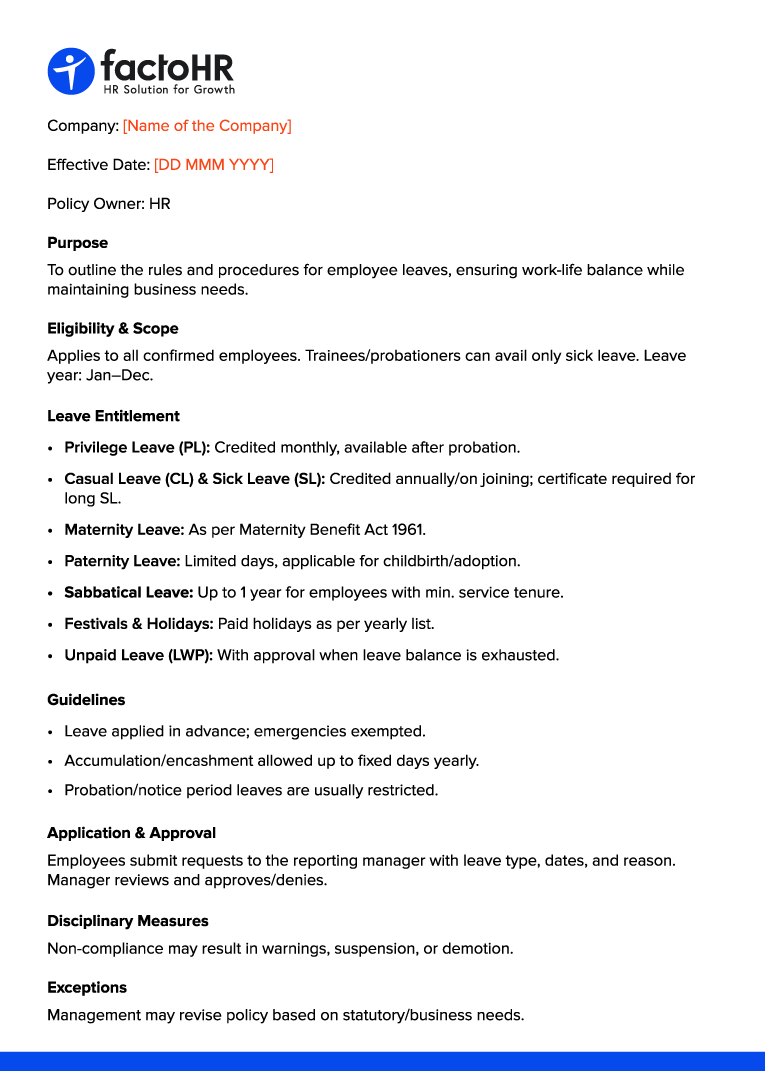Leave Policy Template: Free Ready-To-Use Policy Format
Get Free Leave Policy PDF Template – Easy to Customize
Table of Contents
In India, managing compliance leave policy is complex. With different state rules, evolving labor codes, and varying entitlements, even well-meaning organizations can struggle to stay compliant, sometimes facing fines or employee disputes as a result.
Without a clear HR leave policy, HR managers face the same challenges repeatedly, like confusing approvals, inaccurate leave balances, unclear sandwich rules, payroll mismatches, and frustrated employees. Over time, this lack of clarity affects trust, job satisfaction, and retention.
This is where factoHR’s leave policy template can help. It is ready to use, legally aligned, and easy to adapt, covering everything from eligibility and accrual to carry forward, encashment, and approval workflows. When paired with factoHR’s automation tools, it standardizes processes, ensures compliance, and makes leave management transparent for everyone.
In this guide, we will help you understand the legal basics, provide practical tips, and share best practices. Our goal is to help an organization move from confusion to clarity and shift from manual tracking to easy, automated leave management.

Leave Policy Format
The leave policy is a formal document that draws attention to various employee guidelines when taking time off. With this Leave policy format for employees, you can help your company go through the format to make use of and implement the same in your organization.

At “Name of the Company,” we value and provide our employees with a reasonable and regular amount of time off from work. An employee leave of absence policy describes the rules and procedures for employees willing to take time off. We understand that balancing professional and personal life is necessary. However, depending on the situation, the company can only approve or refuse the leave application.
Purpose
This policy describes the guidelines for employees requesting leave of absence and specifies the types and number of leaves each employee is entitled to in a calendar year.
Eligibility
A leave policy covers all regular and confirmed employees, but trainees or employees on probation can only take sick leave. The leave year runs from 1 January to 31 December.
Scope
This leave policy applies to all employees in the organization.
Leave Entitlement
All the employees are entitled to Leave, and the types of leave are as follows.
- Privilege Leave
- Casual Leave
- Sick Leave
- Maternity Leave
- Paternity Leave
- Sabbatical Leave
- Festivals and Holidays
- Unpaid Leave
Guidelines
- The leave calculation will be done on a calendar year basis.
- Casual or sick leaves will be credited to the employee’s Leave account at the start of the calendar year, which is 1 January or the date of joining for new employees.
- Privilege leave will be credited to the employee’s Leave account at the beginning of every month accordingly.
- Employees joining after the date will receive their leave entitlements, proportionally calculated based on the time remaining that year.
- Privilege leave is entitled only after the employee completes probation or whenever their employment is confirmed.
- Casual or sick leave cannot be availed for more than “number of days.”
- Casual or sick leave cannot be availed for less than “number of days.”
- If you request leave for more than the “number of days,” you must submit a doctor’s certificate.
- The company has the right to refer any employee to a doctor to determine the seriousness of the sickness.
- The leaves should be applied in advance for “number of days”.
Festivals
Apart from the above-mentioned leaves, there will be a number of days paid holidays. The list for the same will be released at the beginning of the calendar year. Note that these holidays cannot be carried forward or encashed.
Leave without Pay
Employees can apply for leave without pay when their leave balance is zero or negative. This is necessary to maintain the hierarchy and chain of command. The reporting manager will send his suggestion to the Head of HR for final approval. Holidays falling under week-offs will not be paid. LWP for more than “number of days” requires permission from the Director or CEO.
Sabbatical Leave
Employees who wish to enhance their qualifications relevant to their jobs can take a sabbatical leave for up to one year, provided they have a minimum of “number of years” of continuous service within the organization. The HOD should send recommendations to the head of HR for the CEO’s final approval.
Maternity Leave
Maternity leave benefits will be granted to women not covered under the ESI Act as per the Maternity Benefit Act 1961. In case of sickness or illness related to pregnancy, leave can be extended up to a maximum “Time frame,” which will be adjusted against the employee’s leave balance.
Paternity Leave
The benefits of paternity leave will be granted to all male employees for a maximum of a “Time frame” on account of childbirth or adoption of a child. This is applicable for up to “Number of children” children. Paternity Leave needs to be availed within the “Time frame” of the birth of the child.
Leave during Probation or Notice Period
Employees serving probation and notice periods will/will not usually be allowed to take leave.
Leave Accumulation/Encashment Policy
Any employee is allowed an accumulation of a maximum of “Number of days” days of leave. The accrued leaves will automatically get encashed at the beginning of the following calendar year. Any time the accumulated leaves exceed the “Number of days”, they can encash the excess leaves. For this, the previous year’s only leaves will be considered.
Application Process
All employees must submit their leave request application to their reporting manager within 30 days. There is an exception for emergencies. The request should include the type of leave, start and end dates, and the reason.
Approval Process
The reporting manager will review the request and decide whether to approve or deny the leave. If the leave is approved, the manager will inform the employee.
Disciplinary Measures
The reporting manager and HR head will take strict action if the policy is not followed. These can range from verbal or written warnings for minor violations to suspension or demotion for serious violations.
Exception
Management may modify the above policy based on statutory requirements or business needs. However, exceptions will only be permitted if the Head of HR approves them.
If you’d like to explore how to design a fair and compliant HR leave policy for your workplace, take a look at this step-by-step guide

What are the Various Leave Rules for Employees?
Leave rules explain how employees can take time off work in corporate organizations. They outline eligibility for leave accrual, the application process, approval, required documents, carryover, or cash-out options.
- Earned leave is for planned time off and accrues based on days worked. There are rules about how much is earned, who is eligible during probation, how much notice to give, and limits on carryover or cashing out.
- Casual leave is for short, unexpected absences. It includes rules for how many days can be taken each year and allows for half-day usage. In some states, it can also be grouped with sick leave.
- Sick leave is for illness or accidents and has annual limits and requirements for a medical certificate. Some states do not let you carry it over or cash it out.
- Maternity leave follows specific laws, with rules for documentation, benefits, and returning to work.
- Discretionary leave types, such as paternity leave, bereavement, marriage, and sabbatical leave, are set by the employer. These rules define who can take leave, how long it lasts, and what proof is needed.
- Compensatory Off has rules for eligibility, claiming, and approval. This leave has a short time frame to prevent too much accumulation.
Lastly, the system must set up workflows, adjust for new hires mid-year, and handle year-end processing to ensure fairness and ease of tracking across all employees and locations. If you’d like to understand all the leave types and how they work in India, take a look at this comprehensive guide.
Role of HR & Line Managers in Leave Administration
- Policy design and classification: HR should create a clear and compliant leave policy template for employees. This policy should explain the difference between leave under the Factories Act and the state Shops & Establishments Acts. It must define who qualifies for leave, how it accrues, any carry-forward rules, and how encashment works. Simple policy should include the requirements for maternity leave as set out in the Maternity Benefit Act.
- Administration and controls: Line managers should approve leave based on roster needs and proper notice times. HR will handle timely wage payments during leave, provide leave in lieu when someone exits, and ensure compliance with maternity provisions, including access to crèches and the option to work from home when possible.
- State-by-state compliance: HR needs to keep a state-by-state record of leave policies in India for each location where we operate. This includes differences, such as how Maharashtra handles earned leave and how Delhi protects payouts. HR must also update the policies when states change their Shops & Establishments rules.
- Record-keeping and audits: Maintain detailed leave ledgers, balance reports, and inspection-ready registers; conduct periodic audits to verify accruals, carry-forwards within caps, and accurate encashment calculations tied to separation events or government-allowed mechanisms.
- Training and communication: Equip managers to interpret eligibility (e.g., 240-day rule in factories), handle maternity leave requests compliantly, and escalate edge cases (refusals, payouts on discharge) to HR for statutory processing and documentation.

Take the Next Step
A firm leave policy is the foundation of a productive workplace that benefits both employees and the organization. It reduces stress and burnout and improves mental and physical health for employees. For organizations, it leads to higher productivity and a strong employer brand.
To learn more about the HR Leave policy template, you can either download this template in PDF or Word form. To acquire more information on the appropriate way to manage and monitor employee leave, utilize factoHR’s leave management module. It is a top-shelf software that streamlines and automates an organization’s leave management, making it very practical and accurate.
What Features Make a Good Leave Policy for Private Companies?
A good leave policy for employees is one that clearly explains the different types of leave, eligibility criteria, how leave is earned, carried forward, or encashed, and the process for applying and approving it. It should also comply with location-specific laws, be easy to understand, and be supported by an HR system for proper tracking and fairness.
What is the Leave Policy for the Weekend?
For weekends, the law ensures employees get at least one weekly rest day. If someone works on a weekend, a compensatory rest day is still required. Whether weekends are counted as part of a leave depends on the company’s “sandwich rule,” which needs to be stated clearly in the leave policy for employees.
How to Prepare a Holiday/Festival List for Employees or Organizations?
When preparing a holiday or festival list, companies should start with the mandatory national and gazetted holidays, then add regional festivals relevant to their locations. The list should be finalized early in the year, approved by management, and easily accessible to employees so they can plan ahead.
How Many Paid Leaves are Private Companies Required to Give in India?
The number of paid leaves private companies must provide in India varies by state. Many states grant around 12 days of casual or sick leave (combined or split) along with 12–18 days of earned or privilege leave annually. Factories follow the Factories Act, which allows one day of leave for every 20 days worked once the 240-day threshold is met.
Can Earned Leave be Carried Forward or Encashed?
Earned leave can usually be carried forward within statutory or policy limits, and in many cases, it can be encashed either when the employee leaves the organization or at year-end, depending on the rules. Any encashment may have tax implications under Section 10(10AA) of the Income Tax Act.
Is Maternity Leave Mandatory in Private Companies?
Maternity leave is mandatory for eligible women employees under the Maternity Benefit Act, which applies to establishments with 10 or more employees. The law provides for up to 26 weeks of paid leave and also covers cases like adoption or commissioning motherhood, with penalties for companies that fail to comply.
Transform your HR operations with factoHR today
Choose a perfect plan satisfying your business demands and let factoHR handle all your HR’s tasks efficiently.

© 2025 Copyright factoHR


